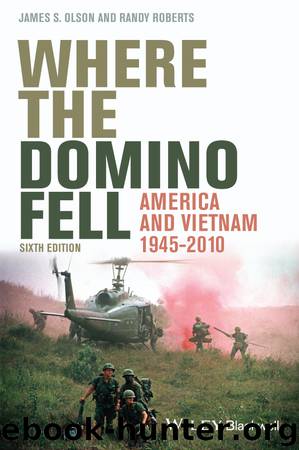Where the Domino Fell by James S. Olson & Randy Roberts

Author:James S. Olson & Randy Roberts
Language: eng
Format: epub
Publisher: Wiley
Published: 2013-08-28T16:00:00+00:00
Over time, Komer worried more about the political consequences of American bombing and artillery fire in South Vietnam, especially as the number of accidental civilian deaths approached one million people. When the United States first entered South Vietnam, one of its supreme objectives had been to protect peasants from the depredations of the Vietcong. But instead of safety and security, the United States brought death, destruction, and homelessness on a wide scale, and it was easy for Vietcong and North Vietnamese propagandists to convince many peasants that their miseries came from the United States, not from the communists.
Adding to Washington's frustration over the government of Nguyen Cao Ky and Nguyen Van Thieu was their inability to reach an accommodation with the Buddhists. Both Ky and Thieu were Roman Catholics; both were drawn to the French; both were critical of Buddhist values; both were military officers. Led by Thich Tri Quang, the most prominent Buddhist monk in the country, northern Buddhists demanded a civilian government sympathetic to Buddhist culture and Vietnamese independence. The most prominent of the Buddhist dissidents was Nguyen Chanh Thi, the “Warlord of the North,” a close associate of Thich Tri Quang. Thi had risen through the ARVN ranks to become commander of I Corps in 1965. American marines in I Corps respected Thi for his courage and aggressiveness. In March 1966 Ky traveled to Hue for some military conferences, but Thi snubbed him, calling Ky “my little brother” and ridiculing him in public. Upon returning to Saigon seething with anger, Ky relieved Nguyen Chanh Thi of his command and put him under house arrest. It was just the signal the Buddhists had been waiting for. Thich Tri Quang organized widespread protest demonstrations throughout the northern regions of South Vietnam, claiming that the military government was capricious and dictatorial and calling for creation of a civilian, constitutional democracy. At the end of March, protesters seized the radio stations in Hue and Danang. Promising to “liberate Hue and Danang from the communists,” Ky led two Vietnamese marine battalions into Danang and waited for the protests to die out. When they did not do so, he attacked Danang and had to fight his way through ARVN troops still loyal to Thi. The battle, some of it house-to-house combat in Danang, lasted more than a week. In Hue demonstrators attacked the United States Consulate, and Ky had to take military control of the city early in June.
The civil war in Danang and Hue in 1966 raised more doubts in the United States about Nguyen Cao Ky. Breaking the back of the Buddhist political movement had been expensive, especially in American public opinion. American troop levels were approaching 300,000, casualties were mounting, and now television was broadcasting images of South Vietnamese fighting South Vietnamese. Relative casualty figures were also affecting American public opinion. By the end of 1965 there were supposedly 514,000 men serving in the South Vietnamese armed forces along with 184,000 Americans. In 1966 more than 6,000 American soldiers died in Vietnam, as did nearly 12,000 South Vietnamese soldiers.
Download
This site does not store any files on its server. We only index and link to content provided by other sites. Please contact the content providers to delete copyright contents if any and email us, we'll remove relevant links or contents immediately.
| Arms Control | Diplomacy |
| Security | Trades & Tariffs |
| Treaties | African |
| Asian | Australian & Oceanian |
| Canadian | Caribbean & Latin American |
| European | Middle Eastern |
| Russian & Former Soviet Union |
The Secret History by Donna Tartt(16618)
The Social Justice Warrior Handbook by Lisa De Pasquale(11489)
Thirteen Reasons Why by Jay Asher(7786)
This Is How You Lose Her by Junot Diaz(5767)
Weapons of Math Destruction by Cathy O'Neil(5034)
Zero to One by Peter Thiel(4823)
The Myth of the Strong Leader by Archie Brown(4789)
Promise Me, Dad by Joe Biden(4444)
Stone's Rules by Roger Stone(4415)
Beartown by Fredrik Backman(4413)
How Democracies Die by Steven Levitsky & Daniel Ziblatt(4396)
The Fire Next Time by James Baldwin(4341)
100 Deadly Skills by Clint Emerson(4075)
A Higher Loyalty: Truth, Lies, and Leadership by James Comey(4031)
Rise and Kill First by Ronen Bergman(4012)
The David Icke Guide to the Global Conspiracy (and how to end it) by David Icke(3881)
The Farm by Tom Rob Smith(3871)
Secrecy World by Jake Bernstein(3782)
The Doomsday Machine by Daniel Ellsberg(3730)
